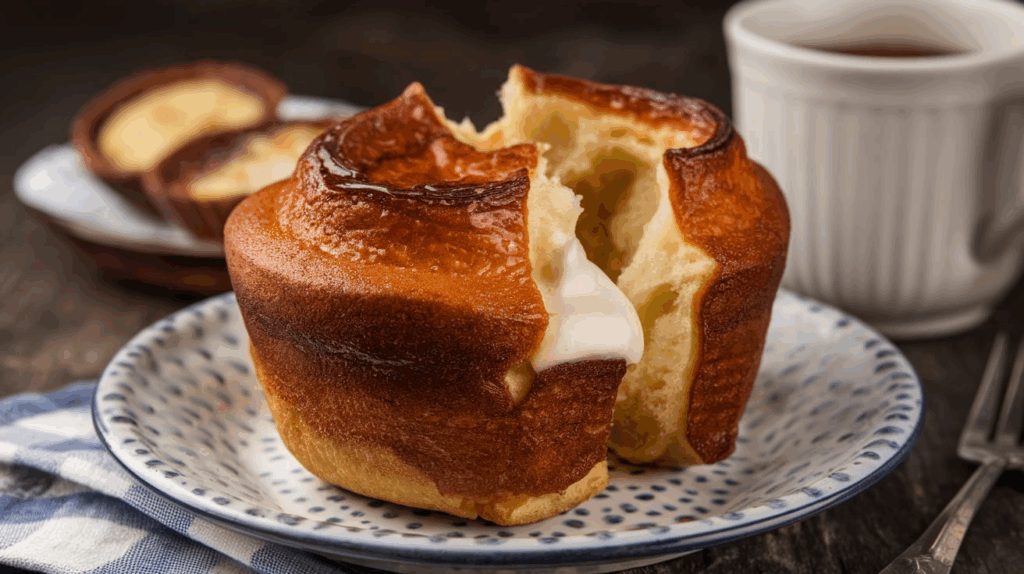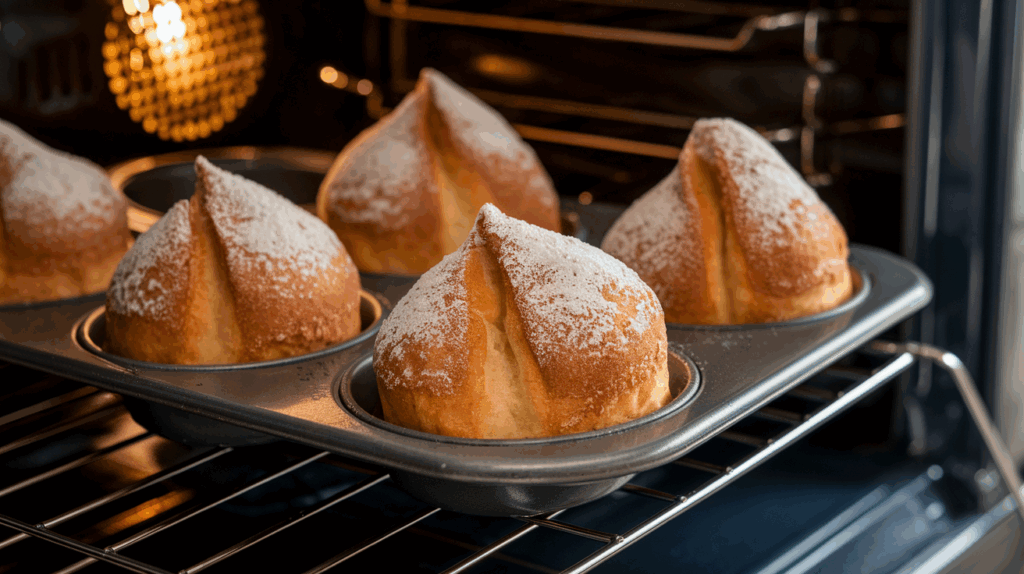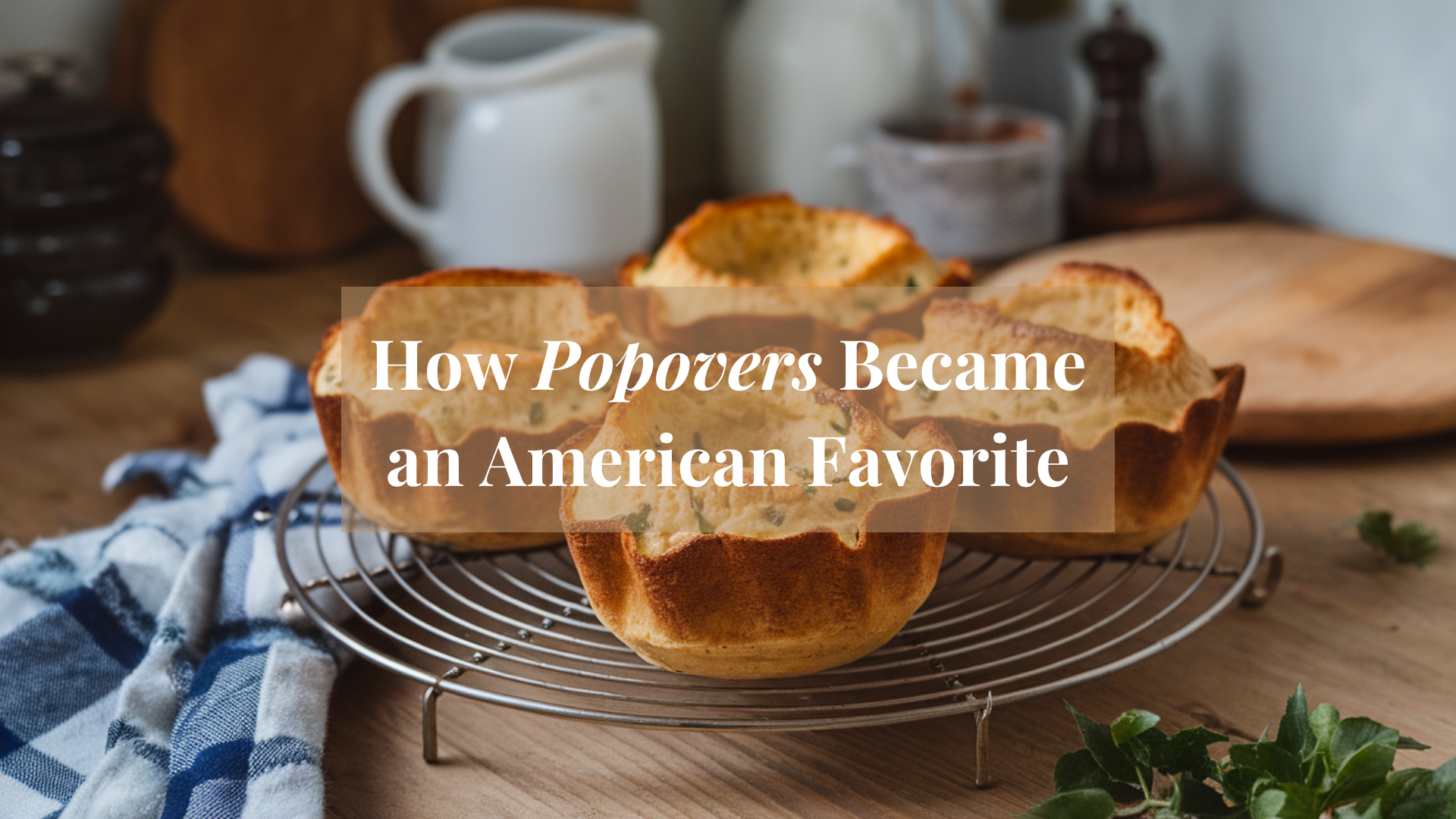Popovers are a light, airy pastry that has been loved for generations. They have a crisp outside and a soft, hollow inside, making them the perfect treat for any meal.
You’ve probably seen them served at fancy restaurants or enjoyed them as a warm side with dinner. But have you ever wondered where they come from?
The story of Popovers is actually quite interesting. It all starts with a recipe similar to Yorkshire pudding, a traditional English dish. Over time, popovers made their way to America and became a popular choice for many.
In this blog, I’ll talk about the origin of popovers, how they evolved, and why they are still so popular today.
Understanding Popovers

Popovers are a type of baked good that are light, fluffy, and slightly crispy on the outside. They get their name because the batter “pops over” the top of the pan as they bake, creating a puffed-up shape.
The inside is hollow, making them perfect for stuffing with butter, jam, or even savory fillings like cheese and herbs.
These little treats are made from a simple batter of eggs, milk, flour, and butter. The ingredients are mixed together and baked in a special pan, usually a muffin tin or popover pan, which helps them rise high and form their unique shape.
While they may seem fancy, they’re actually quite easy to make, and they pair well with a variety of meals, whether sweet or savory.
Tracing the Origins of Popovers
Popovers might seem like a modern treat, but they actually have a long history that traces back to England. The story starts with Yorkshire pudding, a classic British dish. Yorkshire pudding is made from a similar batter and is traditionally served with roast beef.
It’s cooked in the same way, with the batter puffing up in the oven. In the 17th century, Yorkshire pudding was made with beef drippings, giving it a savory flavor.
When English settlers came to America, they brought this recipe with them. Over time, people started making their own version of the dish, but without the beef drippings.
Instead, they used butter or other fats, which helped create the lighter, airier texture we now know as popovers. The name “popover” came from how the batter would “pop over” the sides of the pan as it baked, making it rise high and form a hollow center.
Popovers started becoming more popular in the United States in the 1800s, especially in New England. They were served in fancy restaurants and even at home as a treat with dinner or brunch.
While they’re similar to Yorkshire pudding, popovers are lighter and have a more delicate texture, making them a favorite in many American kitchens today.
Historical Milestones
Popovers have a rich history that shows how this puffy bread became a beloved American treat. Let’s see how these hollow rolls found their place on American tables:
Earliest References
- The first written mention of popovers dates back to the 1850s. They started showing up in cookbooks around this time, and one of the earliest recipes appeared in a cookbook by M. N. Henderson in 1876.
- These early recipes were very similar to the ones we use today, with ingredients like flour, eggs, milk, and butter. As more people started making them, popovers began to become a popular dish in many American households.
Regional Variations
- As popovers became more popular, different regions of the United States started modifying the recipe. In Portland, Oregon, for example, chefs began adding garlic and herbs to the batter, giving the popovers a unique flavor.
- Some people even started making sweet versions of popovers, adding things like pumpkin puree or cinnamon for a dessert-like treat. These different styles of popovers show just how versatile they are.
By the late 1800s and early 1900s, popovers were a staple in many homes and restaurants, and their popularity has only grown since then.
Popovers in Modern Times
Today, popovers are a popular treat found in many American kitchens and restaurants. They’re loved for their light, airy texture and their ability to complement both sweet and savory dishes.
Popularity and Serving Suggestions
- Popovers have remained a favorite at both casual and fancy meals. They’re often served as a side dish at dinner, especially with roast meats or soups. But you can also find them at brunches, filled with sweet toppings like fresh fruit or whipped cream.
- Some people even make popovers for special occasions, like holidays or family gatherings, because they add a touch of elegance to the meal.
- Another great thing about popovers is how easy it is to experiment with them. You can make them sweet by adding cinnamon, vanilla, or chocolate chips or savory with cheese, garlic, or herbs.
Distinctions from Similar Pastries
- While popovers may seem similar to other pastries like cream puffs or éclairs, they are actually quite different. Popovers are lighter and less sweet, with a hollow center, while cream puffs and éclairs are typically filled with cream or custard.
- The batter for popovers is simple and made with basic ingredients, which gives them a light texture. What really sets popovers apart is their unique baking method—using a hot oven and a special pan helps them rise and “pop over” the sides.
Popovers continue to be a beloved part of American food culture. They’re still a fun and delicious way to impress guests or enjoy a special treat with family. Whether served with a savory dinner or as a sweet snack, popovers will always be a favorite!
How to Make Perfect Popovers?

Making popovers might sound tricky, but with the right steps, you can easily create these light and fluffy treats at home.
1. Preheat the Pan: One of the most important things to remember is to preheat your popover pan or muffin tin in the oven before you add the batter. This helps the popovers rise quickly and gives them that signature puffed-up shape. Heat the pan for about 10 minutes at 450°F (232°C) before you pour in the batter.
2. Use Room Temperature Ingredients: For the best results, make sure your eggs, milk, and butter are at room temperature. Cold ingredients can cause the batter to clump and prevent the popovers from rising properly.
3. Don’t Overmix the Batter: When you mix the batter, be careful not to overdo it. A few lumps are okay! Overmixing can cause the batter to become too thick, which might lead to dense popovers. Just stir until everything is combined.
4. Don’t Open the Oven Door: It’s tempting, but try not to open the oven door while the popovers are baking. The cold air will cause them to deflate. Let them bake without peeking for the full cooking time, about 25-30 minutes.
By following these simple tips, you’ll be on your way to making perfect, light, and fluffy popovers every time! Enjoy them fresh out of the oven, and don’t forget to get creative with different fillings or toppings!
Common Mistakes to Avoid
Making popovers is fun, but a few common mistakes can prevent them from turning out perfectly.
1. Opening the Oven Too Soon: If you open the oven door before the popovers are done baking, they can collapse. It’s best to leave them alone while they bake to avoid this.
2. Underbaking: Popovers need to be baked all the way through to be light and fluffy. If you take them out too early, they might not puff up or get that crisp golden color.
3. Using Cold Ingredients: Cold eggs or milk can cause the batter to react poorly. Make sure your ingredients are at room temperature for the best rise.
By avoiding these simple mistakes, you can make popovers that are perfectly puffed and delicious every time!
Conclusion
Popovers are a delicious and fun treat with a rich history that goes back to England. From their humble beginnings as Yorkshire pudding to their rise in popularity in America, they’ve become a beloved part of many meals.
Whether served as a savory side or a sweet snack, popovers are versatile and easy to make once you know the basics.
By following a few simple tips, like using room temperature ingredients and preheating the pan, you can make perfect popovers every time. And remember, it’s okay to experiment with different flavors, so don’t be afraid to try new recipes!
With their light, airy texture and golden crust, popovers are sure to impress at any meal. So next time you want to try something different in the kitchen, give popovers a go—they’re sure to become a new favorite in your home!
Frequently Asked Questions
How Do Popovers Get Their Name?
Popovers get their name from the way the batter “pops over” the sides of the pan as it bakes, creating a puffed-up shape with a hollow center.
Can I Make Popovers without Eggs?
Eggs are essential to the structure of popovers, but you can try using egg substitutes like flaxseed or chia seeds mixed with water to create a similar texture, though the results may vary.
Can Popovers Be Frozen?
Yes, you can freeze popovers. Let them cool completely, then wrap them in plastic wrap or foil and store them in a freezer-safe bag. When you’re ready to enjoy them, reheat them in the oven.
Are Popovers Gluten-Free?
Traditional popovers are made with regular flour, so they’re not gluten-free. However, you can try substituting gluten-free flour for a gluten-free version.

